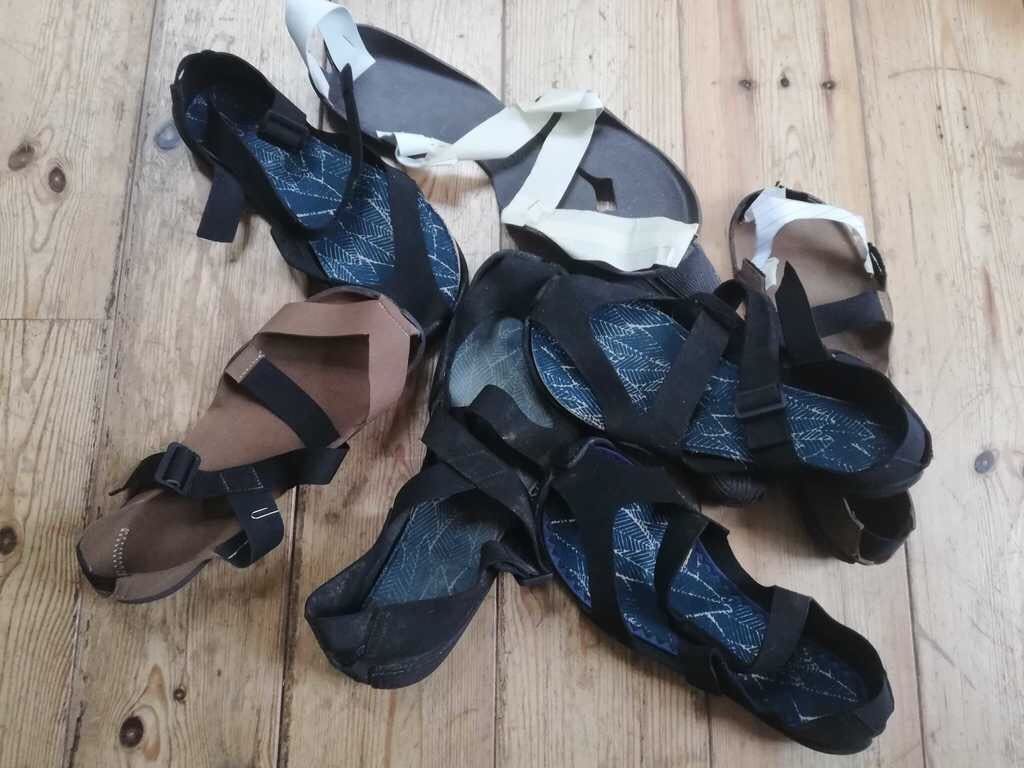This year we again came very close to not having a sandal! We almost gave up. We thought that if the sandal wasn’t going to be a Wildling sandal, then why bother? There are plenty of options out there.
Wildling's first sandals, the Owl and Lynx, was a good start, but it had some flaws - it was too closed up and in many cases applied a lateral force (valgus) to the big toe. So we needed to improve it.
But how do you make an even more minimal sandal and still keep it functional?
Like with all our designs, our main objective was to build the sandal based on the windlass mechanism. The sandal had to use the big toe to maintain contact with the foot. It also had to carry the bare minimum of materials and be open, but not in a way that would make the thin outsole flip and flop in the front.
The tricky part, again, was the outsole. We felt we had to use the Wildling outsole for the sandal, too, but considering how unstable and flexible it is, it wasn't going to be an easy fix.
Back to the drawing board with the product team, and to the trails to try out different designs. Nothing worked. It was either too open, too closed, the foot slipped out, or it simply didn't have the right look.
Going with a normal flat outsole would have made our lives so much easier and would have opened up a whole range of different designs. All of them could have been very good sandals, but they wouldn't have been Wildlings.
Ran can testify that for the last two years, the sandal was the last thing on his mind before going to sleep at night and the first thing when waking up.

One of Ran's "prototypes". Image: Wildling Shoes
But then it hit us - sandals are always assembled out of an upper part that closes around the foot, and an outsole. Two parts, or more. A rigid sole allows you to have a minimal upper, and if you use a loop around the big toe or something in between the toes, the sandal can hold ok. We didn't want any of the three, so in order to have maximum stability and strength with a minimum amount of material, together with our outsole, the sandal would have to be made from one piece! One pattern complementing the outsole. Great! But how??? To the best of our knowledge, that had never been done before, so was it even possible?

The pattern of the Wildling sandal "Feather". Image: Wildling Shoes
A team of 6 people racked their brains for almost a year, looking for the perfect solution, and after numerous prototypes we feel confident enough to say that we’ve nailed it!!!
The Feather is made of one piece of microsuede, without any additional parts besides the outsole.

The prototypes of the Wildling Sandals "Feather Dove" and "Feather Raven" looked like this. Image: Wildling Shoes
Why Microsuede? Of course we thought about it carefully, and if it had been up to us we’d have loved to go with natural materials. But working with this pattern requires a “raw-edge” material that doesn't need to be seamed. So the only options were leather or microfibre. Since leather isn’t completely unproblematic either (tanning, dying), and is of animal origin, we decided to go with the microfibre, which is also used in every other Wildling. There’s not much more microfibre in a Feather than in the other Wilding models.
It connects in only two places to close the pattern, wrapping snugly around the foot with a feather-light touch.
This not only has more than enough strength to hold in any conditions, but also gives it a glove-like feeling.
We welcome the summer with a wild feathery touch!
Header image: Wildling Shoes



